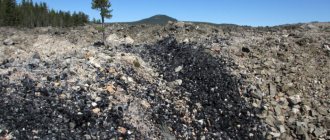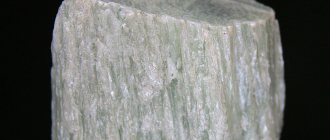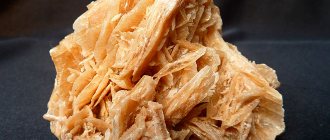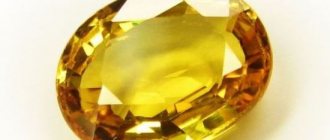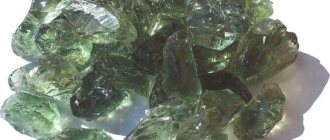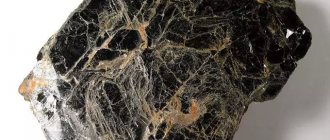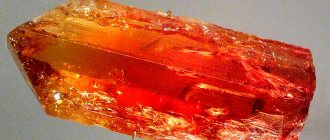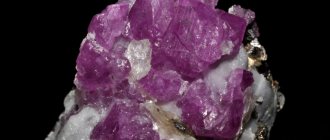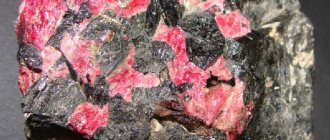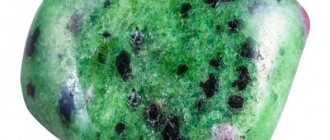Bornite is a mineral, sulfide of copper and iron. Named in honor of the Austrian mineralogist I. Born. Outdated synonyms are “variegated copper pyrite”, “purple copper”. It has two polymorphic modifications: a high-temperature modification - cubic-hexaoctasdrical, and a low-temperature modification - tetragonal-scalenohedral.
| Bornite | |
| Formula | Cu5FeS4 |
| Physical properties | |
| Color | Copper red, indigo |
| Stroke color | Dark gray to black |
| Shine | Metal |
| Transparency | Opaque |
| Hardness | 3—3,5 |
| Cleavage | Imperfect by (111) |
| Kink | Conchoidal; fragile |
| Density | 4.9—5.3 g/cm³ |
| Crystallographic properties | |
| singonia | Rhombic, Cubic, Dodecahedral, Octahedral |
Bornite definition
Bornite is a fairly common mineral belonging to the subclass of complex sulfides. Researchers note that it is one of the main components of ores containing copper. The stone has been known since the beginning of the 18th century, but then had other names. We list those that were used most often:
- mottled copper ore;
- variegated copper pyrite;
- purple copper.
Later, the mineral bornite received its main name. It was named after Born, a famous geologist and metallurgist from Austria, the name was given by geologist Bedan. It is interesting that the mineral began to be mined in Russia in very distant times. Back then it was still known that bornite could be divided into 2 types:
- high temperature;
- low temperature
These polymorphs differ depending on whether the temperature limit of 228 °C is exceeded. At this temperature a transition occurs. In some cases, the mineral is called very elegantly - peacock ore. The fact is that in some cases, when turning the stone, a purple glow is revealed, shimmering like the feathers of a peacock.
Bornite mineral: description, origin and formula
Bornite industrial mineral Bornite is a fairly common mineral belonging to the subclass of complex sulfides.
Researchers note that it is one of the main components of ores containing copper.
The stone has been known since the beginning of the 18th century, but then had other names.
We list those that were used most often:
- mottled copper ore;
- variegated copper pyrite;
- purple copper.
Later, the mineral bornite received its main name. It was named after Born, a famous geologist and metallurgist from Austria, the name was given by geologist Bedan.
It is interesting that the mineral began to be mined in Russia in very distant times.
Back then it was still known that bornite could be divided into 2 types:
- high temperature;
- low temperature
These polymorphs differ depending on whether the temperature limit of 228 °C is exceeded.
At this temperature a transition occurs. In some cases, the mineral is called very elegantly - peacock ore.
The fact is that in some cases, when turning the stone, a purple glow is revealed, shimmering like the feathers of a peacock.
Bornite, a common mineral, has a formula that is not as simple as it might seem at first glance.
Chemical formula of bornite: Cu5FeS4.
As you can see, the main components of the mineral are copper, iron and sulfur.
More precisely, the substance can be called iron and copper sulfide. Iron in this substance is no more than 10-11%.
It happens that silver can be smelted from bornite ore, since in some cases it is found in the form of an impurity.
The mineral contains solid solutions of the following substances:
- chalcopyrite;
- chalcocite
Most often, bornite has the following color:
- red;
- copper;
- indigo.
It often shines well; it is noted that the shine is of a metallic nature.
It is not transparent or translucent, so it is almost never used in jewelry.
- Hardness: 3.5 on the Mohs scale.
- Density - 5 g/cm3.
The hardness is low, but the density is at the level. The main disadvantage is that the mineral is very fragile and difficult to process.
Rhombic type syngony. Cleavage is imperfect.
Like all complex sulfides, it contains many associated minerals:
- chalcopyrite;
- magnetite;
- quartz;
- enargite;
- calcite;
- pyrite;
- chalcocite
Composition, characteristics of bornite
Bornite, a common mineral, has a formula that is not as simple as it might seem at first glance: Cu5FeS4. As you can see, the main components of the mineral are copper, iron and sulfur. More precisely, the substance can be called iron and copper sulfide. Iron in this substance is no more than 10-11%.
The mineral contains solid solutions of the following substances:
chalcopyrite;
chalcocite
Most often, bornite has the following color:
- red;
- copper;
- indigo.
It often shines well; it is noted that the shine is of a metallic nature. It is not transparent or translucent, so it is almost never used in jewelry. Hardness: 3.5 on the Mohs scale. Density - 5 g/cm3. The hardness is low, but the density is at the level. The main disadvantage is that the mineral is very fragile and difficult to process. Rhombic type syngony. Cleavage is imperfect. Like all complex sulfides, it contains many associated minerals:
- chalcopyrite;
- magnetite;
- quartz;
- enargite;
- calcite;
- pyrite;
- chalcocite
Artificial production of mineral
The breed was first synthesized by Delter in 1925. He heated copper + iron oxides in a tube to 200 °C and passed hydrogen sulfide through them.
Bornite crystals are formed during diffusion:
- chalcopyrite + covellite;
- pyrite + chalcocite.
That is, during the process of hardening the solution, the molecules of one mineral penetrate into the other. They spread throughout the structure, transforming the substance into bornite crystals.
Scientists have found a second way to obtain the breed. The stone is synthesized from a mixture of substances corresponding to its composition, enriched with sulfur. The components are fused in a vacuum.
Gemological examination will help confirm the naturalness of the stone and/or check its composition.
There are fakes of the mineral. More often, colored rocks are sold to beginners. At home, imitation is distinguished by color. If the iridescent layer (tarnish) is scraped off from bornite, the surface will be bronze in color.
Physical and chemical properties of bornite
Sometimes they are confused and say that bornite contains a large amount of boron. This is not true. This impurity is very rare. The mineral is paramagnetic. If you melt it with a blowtorch, it will first crack and only then begin to melt. This is due to the structural features of the crystal lattice.
It can be easily dissolved with nitric acid, and floating formations are observed; this is sulfur. This is how the technological production of sulfur from bornite occurs. It does not react to other acids, including sulfuric acid.
Origin and deposits
Bornite with tarnish
Bornite can have both endogenous and exogenous origin. Bornite of endogenous origin occurs in some medium- and low-temperature hydrothermal deposits. In some cases, it contains microscopic, usually lamellar, chalcopyrite inclusions. In paragenesis with it, in addition to chalcopyrite, there are: endogenous chalcocite, galena, sphalerite, pyrite, etc. Exogenous bornite is widely developed as the earliest secondary sulfide in the form of irregular veins, rims or solid masses. Compared to other secondary copper sulfides, it is less stable and is easily destroyed under weathering conditions.
Relatively rare, does not form large clusters. Typically as dissemination or veinlets in quartz or calcite in association with other copper sulfides. Also isolated, usually poorly formed small crystals in voids and on crack walls. In near-surface conditions it is unstable and easily destroyed by weathering or transformed into chalcocite and covellite. It is found in small quantities in many deposits of the Urals in the upper zones of secondary sulfide enrichment. Also the Dzhezkazgan and Sayak deposits (Kazakhstan), the copper shales of Mansfeld (Germany), Lubin near Legnica, (Poland), Slovenia, Butte (Montana, USA), Tsumeb (Namibia).
Bornite distribution and mining
Although the mineral is common, large accumulations are rare. It is of hydrothermal origin, therefore it occurs together with the following minerals:
- limonite;
- azurite;
- malachite;
- cuprite.
Distributed throughout the world. Some of the most interesting deposits are located in South America: Chile and Peru. There it occurs as part of the “variegated ore,” as the locals call it. It has a pronounced tarnishing effect. What’s incredible is that it is actively used as an ornamental stone.
But in Europe it is believed that bornite is not suitable for this. These ores are also valuable because they often contain impurities of non-ferrous metals. For example, sometimes it is possible to smelt a certain amount of silver and gold from them, and this is an important factor.
The mineral is very common in North America. In the USA, it is mined in several states. But the largest crystals are found in Kazakhstan; they sometimes reach a size of 7 cm. In Europe, development is carried out mainly in Italy, but bornite is also mined in Austria. In Russia, not surprisingly, the stone can be found in the Urals, which is a mineral cradle.
Features of the mineral
The mineral belongs to the class of complex sulfides . It is one of the important components of copper ores. Copper and iron sulfide received its official name in mineralogy only in the first third of the 19th century, although it was found much earlier. French geologist François Sulpice Bedan named the rock after the famous Austrian mineralogist Born, who was a leading German scientist in the 18th century. In Russia, the first samples were discovered in the Northern Urals at the end of the 18th century. Before receiving the name, the rock was called differently: copper purple, variegated copper pyrite, erubescite, poikilopyrite, poikilite. Because of its bluish-purple color, it was also called "peacock ore."
The color range includes violet, blue, violet, red, copper-red, bronze-yellow. The rock develops tarnish colors : iridescent colors that form on the surface of the mineral due to the surface oxide film and the processes occurring in it due to thermal exposure. The color of the ore is variable due to oxidation by air.
The mineral is easily recognizable by its color and variegated tarnish. Externally similar to covellite, but the latter differs in its bluish color when freshly fractured.
Buy bornite
Bornite is a mineral of the sulfide class, copper and iron sulfide, the chemical composition of which is expressed by the formula Cu5FeS4. Among the impurities it often contains Ag. Sometimes Bi, In, Pb, Ge are present. In the form of solid solutions it may contain chalcopyrite and chalcocite.
This mineral has been known under other names since 1725; in Russia, the first data on its findings date back to 1770. The term "bornite" was introduced in 1845 by the French geologist and mineralogist F.S. Bodan (Francois Sulpic Beudant). The mineral was named in honor of the Austrian mineralogist I. Born (IgnazvonBorn 1742-1791).
Synonyms: variegated copper pyrite.
The color of bornite when freshly chipped varies from bronze-yellow to dark copper-red and brown. In air, as a result of the oxidation process, an iridescent, iridescent purple film appears on bornite - predominantly bright blue or red-violet tarnish. Bornite crystals are rare in nature, they are usually blocky, with rough curved faces and have pseudocubic, pseudododecahedral and pseudooctahedral shapes. This mineral is widespread in the form of dense fine-grained aggregates, solid masses, nodules, plates, crusts, thin veins and inclusions. There are lamellar and lattice structures of decomposition of solid solutions with chalcopyrite and chalcocite. Twin germinations are noted. Hardness 3. Brittle. The cleavage is very imperfect. Metallic shine. The fracture is uneven and conchoidal. Opaque. Under the soldering tube it is fused into a magnetic ball. In nitric acid it decomposes with the release of floating sulfur. Possesses electrical conductivity.
Satellite minerals: magnetite, pyrite, chalcocite, chalcopyrite, quartz, calcite, galena, enargite.
Bornite has both endogenous and exogenous genesis. As an endogenous mineral, it is formed in hydrothermal veins, pegmatites, igneous rocks, contact-metamorphic and metasomatic deposits. Bornite of exogenous origin occurs as a secondary mineral in the zone of secondary sulfide enrichment in almost all copper sulfide deposits. Easily replaced by chalcocite and covellite. During decomposition in the oxidation zone along bornite, azurite, malachite, cuprite and other oxygen compounds are formed. Forms pseudomorphs on chalcopyrite. Bornite is sometimes found as inclusions in sedimentary rocks.
Bornite crystals are found in Zimbabwe (Mangula), where their size sometimes reaches 5-7 cm, as well as in the USA and Kazakhstan (Dzhezkazgan). Bornite is known in Canada, Chile, Peru, Poland, Germany, Slovenia, and Namibia. In Russia, this mineral is mined in the Urals, Altai, and Transbaikalia.
Massive granular bornite is one of the important sources of copper. Bornite ores are important not only for their high concentration of copper, but also for their content of gold, silver and other valuable metals. Some samples of this mineral with an iridescent iridescent tarnish are sometimes polished and used as a decorative stone, but after some time the surface oxidizes and becomes dull. Bornite is of great interest to collectors; its crystals are valued for their rarity, and massive specimens for their bright tarnish.
Bornite is considered a stone of joy and optimism. It gives its owner good spirits, love of life, lifts the mood and distracts from sad thoughts. According to lithotherapists, this mineral helps relieve attacks of gout and has a beneficial effect on human bone tissue, strengthening them. An exact correspondence with the signs of the Zodiac has not been established.
